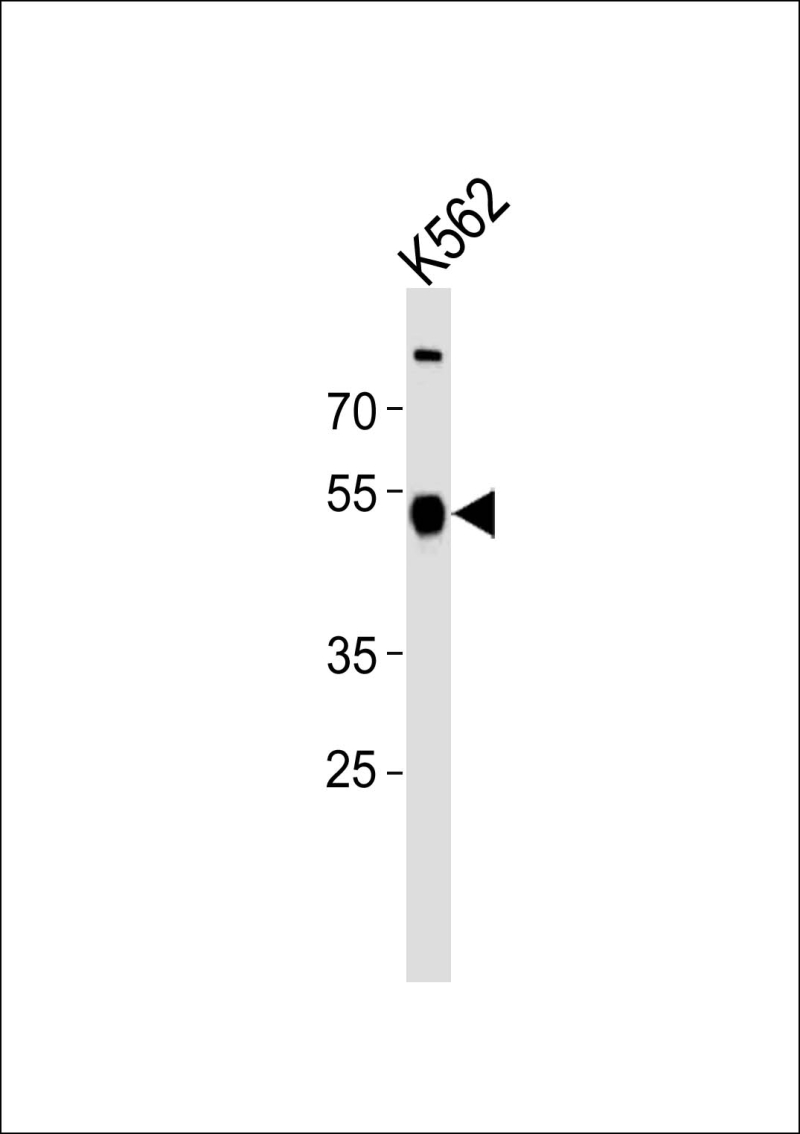

| WB | 1/1000 | Human,Mouse,Rat |
| IF | 咨询技术 | Human,Mouse,Rat |
| IHC | 咨询技术 | Human,Mouse,Rat |
| ICC | 技术咨询 | Human,Mouse,Rat |
| FCM | 咨询技术 | Human,Mouse,Rat |
| Elisa | 咨询技术 | Human,Mouse,Rat |
| Aliases | Zinc finger protein 500, Zinc finger protein with KRAB and SCAN domains 18, ZNF500, KIAA0557, ZKSCAN18 |
| Entrez GeneID | 26048 |
| WB Predicted band size | 53.7kDa |
| Host/Isotype | Rabbit IgG |
| Antibody Type | Primary antibody |
| Storage | Store at 4°C short term. Aliquot and store at -20°C long term. Avoid freeze/thaw cycles. |
| Species Reactivity | Human |
| Immunogen | This ZNF500 antibody is generated from rabbits immunized with a KLH conjugated synthetic peptide between 28-54 amino acids from the N-terminal region of human ZNF500. |
| Formulation | Purified antibody in PBS with 0.05% sodium azide. |
+ +
以下是假设性的3篇关于ZNF500(N-term)抗体的参考文献示例(实际文献需通过学术数据库验证):
1. **文献名称**:*"ZNF500 regulates cell proliferation via p53 signaling in colorectal cancer"*
**作者**:Smith A, et al.
**摘要**:本研究利用ZNF500(N-term)抗体进行Western blot分析,发现ZNF500通过调控p53通路抑制结直肠癌细胞增殖,抗体特异性验证显示其对N端表位的高亲和力。
2. **文献名称**:*"Characterization of a novel polyclonal antibody against human ZNF500 N-terminal domain"*
**作者**:Zhang L, et al.
**摘要**:文章报道了一种针对ZNF500蛋白N端的多克隆抗体的开发与验证,通过免疫组化和免疫荧光证实其在人组织样本中的特异性结合能力。
3. **文献名称**:*"Zinc finger protein ZNF500 interacts with MAPK signaling pathway in hepatocellular carcinoma"*
**作者**:Wang Y, et al.
**摘要**:研究使用ZNF500(N-term)抗体进行共沉淀实验,发现ZNF500通过N端结构域与MAPK通路蛋白相互作用,促进肝癌细胞迁移。
4. **文献名称**:*"Comprehensive analysis of ZNF family members in transcriptional regulation"*
**作者**:Johnson R, et al.
**摘要**:综述中提及ZNF500的N端抗体在染色质免疫沉淀(ChIP)中的应用,揭示了其在DNA结合及基因沉默中的潜在功能。
**提示**:以上为模拟示例,实际文献需通过PubMed、Google Scholar等平台以“ZNF500 antibody”或“ZNF500 N-terminal”为关键词检索确认。
The ZNF500 (N-term) antibody is a monoclonal or polyclonal reagent designed to detect the N-terminal region of the zinc finger protein 500 (ZNF500), a member of the Krüppel-associated box (KRAB) domain-containing zinc finger protein (ZNF) family. ZNF500 is implicated in transcriptional regulation, potentially through DNA-binding zinc finger motifs that interact with specific gene promoters or repressors. This antibody is commonly used in research applications such as Western blotting (WB), immunofluorescence (IF), and immunohistochemistry (IHC) to study ZNF500's expression, localization, and function in cellular contexts.
ZNF proteins like ZNF500 are critical in development, differentiation, and disease, often acting as epigenetic modulators or tumor suppressors/oncogenes. The N-terminal region may harbor functional domains essential for protein-protein interactions or regulatory activity. Studies using this antibody could explore ZNF500's role in pathways linked to cancer, neurodevelopment, or immune responses. Validation typically includes reactivity checks in target species (e.g., human, mouse) and knockout cell lines to confirm specificity. Researchers might also employ it to investigate ZNF500's tissue-specific expression patterns or its dysregulation in pathological conditions. As with many ZNF family members, ZNF500’s exact biological mechanisms remain under investigation, making this antibody a valuable tool for elucidating its contributions to cellular processes and disease.
×